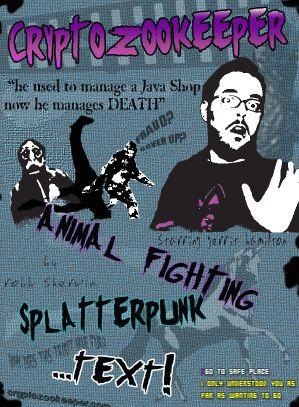(I’m not sure who I wrote this for or where I submitted it to, but I found it on my hard drive and decided to post it here before deleting it. Enjoy!)
In one of the earliest copyright lawsuits involving video games, Atari Corporation sued Magnavox over the release of their 1981 game K.C. Munchkin, claiming it was a direct rip-off of Pac-Man. Although Atari had previously purchased exclusive rights to publish the first home version of Pac-Man, they had not yet released their (infamously bad) conversion for the Atari 2600 when Magnavox beat them to the punch. Magnavox won the original lawsuit, but Atari had the ruling overturned on appeal, forcing Magnavox to pull Munchkin from store shelves. While Atari may have managed to temporarily stop its competitors from releasing Pac-Clones on home gaming consoles, they had no such luck in the realm of personal computers. As Pac-Mania swept the country so did generic Pac-Clones, invading every retro-computing nook and cranny.
One of the earliest Pac-Clones was Scarfman for the TRS-80 Models I and III, written by Philip Oliver and published by Cornsoft Group in 1981. Scarfman set many precedents that Pac-Clones would follow for years to come. The basics of the game are the same as Pac-Man: avoid ghosts while eating dots. Eating a larger power pellet makes the ghosts themselves edible for a short period of time as well. What’s different are the details; for example, there are five ghosts and five power pellets instead of four. Another obvious difference is that the maze does not resemble the original arcade version. This is partly due to the fact that the arcade version of Pac-Man is displayed on a vertical monitor, whereas computer monitors are conventionally horizontal. Rather than trying to force a round peg into a square hole, most Pac-Clone authors opted to simply redesign their mazes to fit the shape of a normal computer monitor. This worked in the favor of computer programmers, who hoped that unique maze designs would keep them from being sued.
That same year (1981) saw the release of Taxman, written by Brian Fitzgerald and published by H.A.L. Labs for the Apple II. H.A.L. Labs had hoped to escape Atari’s wrath by changing a few minor details in Taxman. The ghosts were reborn as insects and squids and given new names, and the bonus fruits were changed into random objects (a cactus?), but the changes were not enough to ward off the long arm of Atari’s lawyers. With a lawsuit looming, H.A.L. Labs withdrew Taxman from the market and either sold or surrendered (I’ve read both versions) the Taxman source code to Atari. After making a few minor graphical updates, Atarisoft re-released Taxman as Pac-Man for the Apple II. H.A.L. Labs went back to the drawing board and released Super Taxman 2, which was similar to Taxman/Pac-Man but used different mazes. Years later, H.A.L. Labs rechristened themselves HAL Laboratory and went on to develop the Kirby and Super Smash Bros. franchises. Taxman programmer Brian Fitzgerald also remained in the game business. You can find his name in the credits of games such as Dark Seed, StarCraft, Diablo I and II, Warcraft II and III, and World of Warcraft.
Unfortunately for Atari, so many Pac-Clones began popping up that their lawyers did not have the time to pursue them all. By 1982 dozens if not hundreds of Pac-Clones had been released, many by small companies that financially weren’t worth legally pursuing. One such clone was Snack Attack, written by Dan Illowsky and published by Datamost. One look at Snack Attack will tell you it is nothing like Pac-Man at all. Instead of a hungry yellow Pac-Man, players controlled a hungry white whale. See? Not the same! Instead of the ghosts being red, blue, pink and yellow, in Snack Attack they are red, blue, green and purple. That’s completely different! And finally, while the dots in Pac-Man are yellow, the dots in Snack Attack are purple and green. Obviously Snack Attack is nothing like Pac-Man at all.
One of the biggest problems Atari had in fighting these waves of generic clones was that many of them were considered to be better than the official Atarisoft versions! (Then again, almost anything is considered to be better than Atari’s version of Pac-Man for the 2600.) Acornsoft’s 1982 release Snapper for the BBC Micro looked nearly identical to the arcade version of Pac-Man, down to the mazes and characters. Again, under the threat of legal action, Acornsoft withdrew and re-released the game with altered graphics (the main character magically sprouted legs and found a green cowboy hat). H.A.L. Labs, whom Apple had sued for their release of Taxman, obtained the license to release home Pac-Man ports in Japan. H.A.L.’s version of Pac-Man for the VIC-20 is superior to Atarisoft’s official version (and beat Atarisoft’s version to market by two full years). To avoid marketing confusion between the two versions, Commodore changed the name to Jelly Monster for its US release.
Some Pac-Clones attempted to avoid the courtroom by creating similar (but not too similar!) maze games. Munch Man for the Texas Instruments TI-99/4A saw a small Pac-shaped character “laying down links” versus eating dots. Another popular maze game, Lock ‘n’ Chase, had players controlling a thief and collecting coins and money bags instead of dots and power pellets. Several other games such as Lady Bug, Amidar, Mouse Trap and Make Trax used similar “maze” concepts, but made enough changes to keep their respective publishers out of hot water.
Other developers simply ignored Atari’s copyright, hoping to fly below the company’s legal radar. Here are just a few known Pac-Clones from the First Church of Pac-Man’s list of False Idols: Ack!-Man, Bac-Man, Dac-Man, Hac-Man, SnackMan, Mac-Man, Plaque Man, Wack-Man, Crap-Man, Chomp, Chomper, Chomper-Man, Gobble-Man, Mouth-Man, Munch Man, and TrashMan, among others. And don’t forget Pac-Bar, PacBoy, Pac-Classic, Pac-Em, Pac-Guy, Packman, PacMac, Pac-Maniac, Pac-Men, Pac-Mon, Pac-PC, PacWar, Pakacuda, Pax, PC-Man, Pucman, and simply Pacman, which, as the site’s webmaster noted, is “just a hyphen away from copyright infringement.”
And if the market wasn’t already flooded with Pac-Clones, it surely was after the release of Data Trek’s Maze Craze Construction Set. Written by Eric Hammond, Maze Craze Construction Set for the Apple II allowed creative Pac-fans to design their own maze games. The program’s editing tools allowed everything from maze layouts to the design and attributes of each individual character to be modified. As a kid I made my own Pac-Clone using the program. I made my game as close to Pac-Man as I could, with the only difference being that in my version, Pac-Man was constantly moving backwards. Its name was naM-caP.
One of the most interesting innovations in the world of Pac-Clones was the transition from two dimensions to three. In 1982, Scott Elder released 3-D Man (also released as 3D Pac Man), a first-person Pac-Clone for the Commodore 64 that literally put players down in Pac-Man’s trenches! Due to the visual limitations of a first person maze game, Elder included a radar on the side of the screen to show players the layout of the maze. The same concept was used the following year in 3-Demon for the IBM PC.
As home computer technology advanced throughout the years, so did the quality of Pac-Clones. Specifically with the advent of VGA and SVGA graphics on DOS machines, colorful Pac-Clones continued to appear. One early popular version was CD-Man, which had players eating dots (of course) while running away from animated spiders. By the mid-to-late 1990s, emulators were powerful and fast enough to run the original Pac-Man arcade code; and yet still, programmers continue to crank out Pac-Clones. Due to the proliferation of the World Wide Web, over the past ten years creators of generic Pac-Clones have migrated to the Internet. There are now hundreds of Pac-Clones online today, written in languages such as Java and Flash. Due to the portability of these languages, many of these Pac-Clones can be now downloaded and played on your cell phone or iPod.
If the thought of playing a Pac-Clone on a small cell phone screen doesn’t sound like much fun, consider Tiny PacMan, a flash-based Pac-Clone which is played on a grid of 10 pixels by 10 pixels. On my monitor, the entire maze appears smaller than my thumbnail. There’s only one ghost (a green pixel) and the dots are flashing purple which, thank goodness, makes them easier to see on such a small scale. The “ghost” gets faster with each level cleared which theoretically makes the game harder. The hardest part for me is simply seeing what’s going on.
One of the newest additions to the Pac-Clone family takes us full circle, back to one of the oldest forms of computer gaming that predates Pac-Man itself: text adventures. Pac-Txt (pac-txt.com) begins by displaying a descriptive paragraph to players: “You awaken in a large complex, slightly disoriented. Glowing dots hover mouth level near you in every direction. Off in the distance you hear the faint howling of what you can only imagine must be some sort of ghost or several ghosts.” Like classic text adventures, the game is played solely through issuing text commands, typed into an interpretor; all information about the game is delivered to players via text as well. Typing “LOOK” and hitting [ENTER] reveals, “You are in a long corridor. You may go forward or backward and there are glowing dots in every direction. There is a glowing dot hovering near you.” EAT DOT [ENTER]. “You have eaten the glowing dot.”
Through years legal battles it has been determined that while specific characters can be trademarked, specific styles or genres of games cannot. And thanks to that ruling, we have more than twenty-five years worth of Pac-Clones available for us to “gobble” up.










